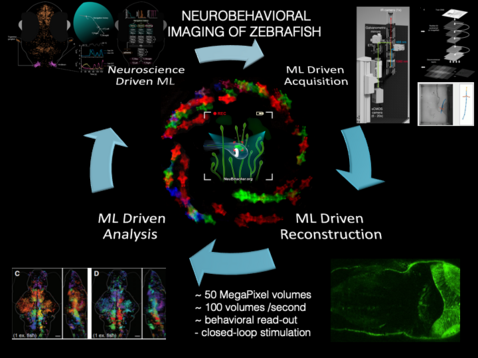AI-driven analysis and image acquisition of in-vivo neuronal network activity

- Sponsored by: TUM Chair of Biological Imaging
- Project Lead: Dr. Ricardo Acevedo Cabra
- Scientific Lead: Prof. Dr. Gil Westmeyer and Dr. Tobias Lasser
Results of this project are explained in detail in the final documentation and presentation.
The zebrafish larva - which has the size of this slash here: / - is currently the only vertebrate model organism that allows for measurements of neuronal activity with cellular resolution across an entire brain. Simultaneously, a rich repertoire of stimuli can be applied in a virtual reality setting, and behaviors can be monitored even in freely behaving animals as we have recently shown (NeuBtracker.org). Even better, neuronal circuit activity can be specifically manipulated by using light-activated ion channels (so-called optogenetic technology).
So this experimental system comes close to the neuroscientific dream about systematically controlling the input, each individual component, and the behavioral output of a living neuronal network to decipher evolutionarily selected functional principles of neuronal information processing. Surprisingly, however, there are still very few custom-designed and robust algorithms available to, e.g., differentiate between spontaneous and stimulus-induced activity patterns, capture the dynamic association of neuronal activity patterns into ensembles, and understand the neuronal computation during fundamental decision processes, such as the switch between fight or flight behavior.
In this project, we will work on already recorded neuronal activity data from zebrafish larvae to first implement state-of-the-art analysis algorithms, that we will then augment with deep learning approaches which can even be incorporated in a closed-loop system for real-time adjustments of stimulation paradigms.
Team members will be co-advised by two faculty members coming from a background in molecular neuroimaging field (westmeyerlab.org) and image analysis and processing (ip.campar.in.tum.de). We believe that this experimental paradigm not only offers an exciting application of AI-driven data analysis and acquisition on fresh and precise scientific data but also has great potential to decipher functional and architectural motives of brain network activity patterns that could provide useful inputs for developing next-generation efficient cross-domain artificial neural networks.
Results of this project will be uploaded here in September 2019.